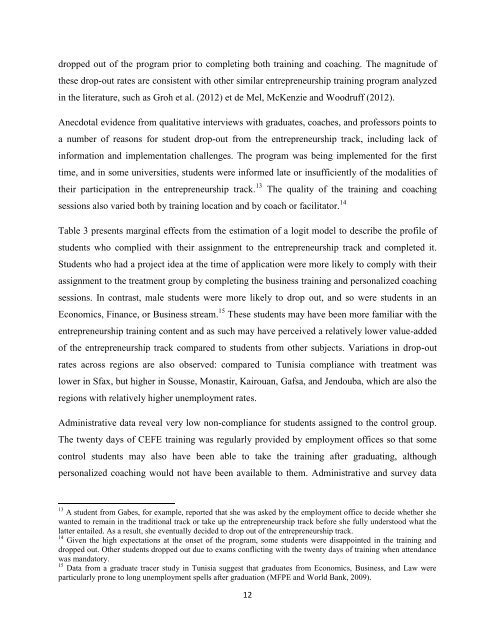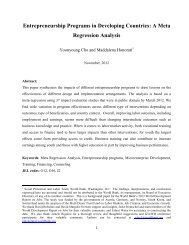Download - Youth Economic Opportunities
Download - Youth Economic Opportunities
Download - Youth Economic Opportunities
You also want an ePaper? Increase the reach of your titles
YUMPU automatically turns print PDFs into web optimized ePapers that Google loves.
dropped out of the program prior to completing both training and coaching. The magnitude ofthese drop-out rates are consistent with other similar entrepreneurship training program analyzedin the literature, such as Groh et al. (2012) et de Mel, McKenzie and Woodruff (2012).Anecdotal evidence from qualitative interviews with graduates, coaches, and professors points toa number of reasons for student drop-out from the entrepreneurship track, including lack ofinformation and implementation challenges. The program was being implemented for the firsttime, and in some universities, students were informed late or insufficiently of the modalities oftheir participation in the entrepreneurship track. 13 The quality of the training and coachingsessions also varied both by training location and by coach or facilitator. 14Table 3 presents marginal effects from the estimation of a logit model to describe the profile ofstudents who complied with their assignment to the entrepreneurship track and completed it.Students who had a project idea at the time of application were more likely to comply with theirassignment to the treatment group by completing the business training and personalized coachingsessions. In contrast, male students were more likely to drop out, and so were students in an<strong>Economic</strong>s, Finance, or Business stream. 15 These students may have been more familiar with theentrepreneurship training content and as such may have perceived a relatively lower value-addedof the entrepreneurship track compared to students from other subjects. Variations in drop-outrates across regions are also observed: compared to Tunisia compliance with treatment waslower in Sfax, but higher in Sousse, Monastir, Kairouan, Gafsa, and Jendouba, which are also theregions with relatively higher unemployment rates.Administrative data reveal very low non-compliance for students assigned to the control group.The twenty days of CEFE training was regularly provided by employment offices so that somecontrol students may also have been able to take the training after graduating, althoughpersonalized coaching would not have been available to them. Administrative and survey data13 A student from Gabes, for example, reported that she was asked by the employment office to decide whether shewanted to remain in the traditional track or take up the entrepreneurship track before she fully understood what thelatter entailed. As a result, she eventually decided to drop out of the entrepreneurship track.14 Given the high expectations at the onset of the program, some students were disappointed in the training anddropped out. Other students dropped out due to exams conflicting with the twenty days of training when attendancewas mandatory.15 Data from a graduate tracer study in Tunisia suggest that graduates from <strong>Economic</strong>s, Business, and Law wereparticularly prone to long unemployment spells after graduation (MFPE and World Bank, 2009).12
















